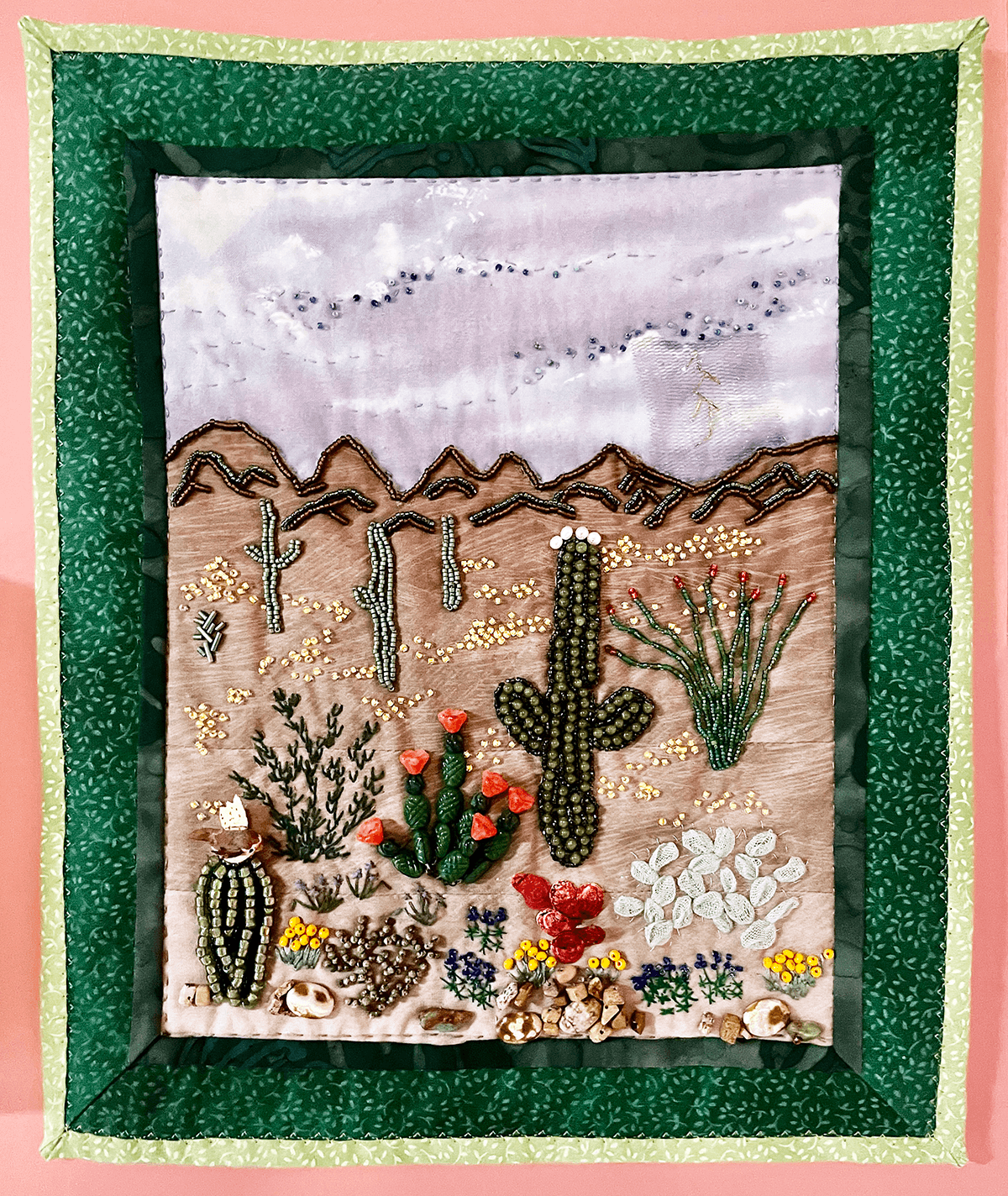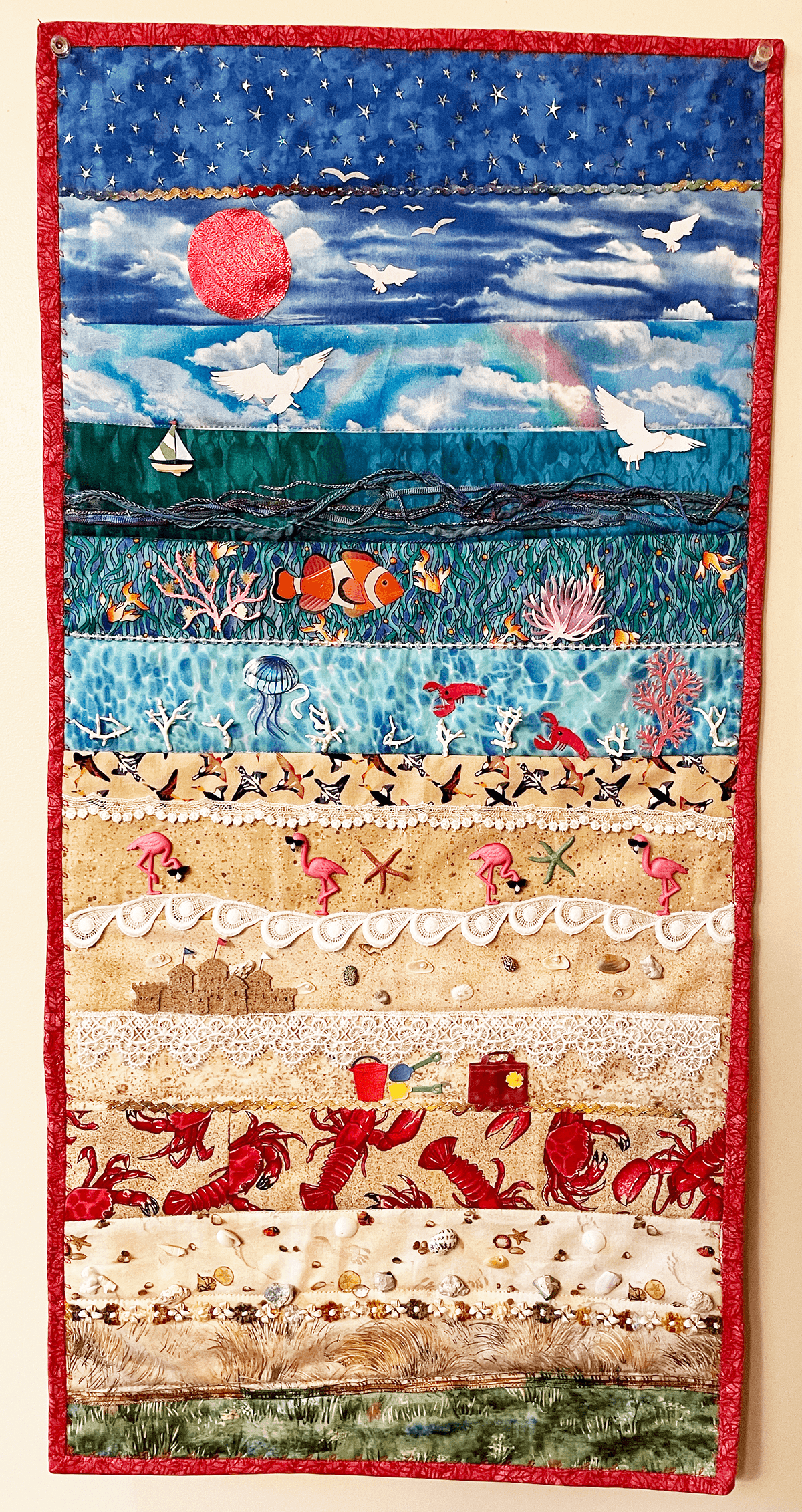Susan Friedman, Illustrative Quilt Artist/Designer
Once in a great while, you come across someone’s work that changes the way you view and think about a “craft” or “hobby.” This happened to me recently when I reconnected with a lovely woman I knew as a youngster in Queens, NY (my older brother’s high school girlfriend, to be exact!) who now—to my surprise and delight—lives 10 miles from me in the Hudson Valley in upstate New York.
In our first phone conversation, Susan Friedman told me about her quilting hobby, but when I saw her work in person in her colorful home, I was blown away by what I saw. To be specific, other than “just” being beautiful, I didn’t expect the illustrative and even biographical nature of her creations. I was also surprised and impressed by her artistry: In addition to the sewing skill required, Susan has an innate feel for color, texture, and a natural eye for design and composition.
As it turns out, today Susan is an award-winning quilt artist; her many awards and ribbons are tucked away discreetly in her workroom. Her creations are frequently more like illustrative collages, since in addition to the use of fabric and other textile findings, they include actual paper photographs, beads, buttons and sequins, sand and pebbles, and other natural and manmade artifacts—all in addition to text and writing when called for.
Her work has been shown in quilt shows and galleries. She decorates her colorful home with them. Since Susan is an avid journaler as well as a quilter, I’ll let her tell you about her quilting journey in her own words.
Q&A
Q: I understand you began quilting at a later age (after being a biology enthusiast and elementary school teacher). How did you come upon this artistic craft?
A: I always made my own clothing. I was at a local quilt show and bought a book, Jacket Jazz by Judy Murrah. It has about 30 different patchwork techniques. I bought a rotary cutter, a Plexiglas ruler, and a cutting mat, made the jacket, and was hooked at age 50! I began collecting fabric, hundreds of dollars worth every month. It was my palette. The largest bedroom in my house became my sewing room and I put shelving, ceiling to floor, in the 8-foot-wide closet. Fabrics are sorted by topic and color—floral, sky, animals, water, trees, fun fabrics, etc.
Every place I traveled to, I’d find the local quilt shop. They had fabrics with prints representing everything there in nature that you wouldn’t find in a regular fabric store.
Q: What was your initial inspiration, and how did your work progress to where it is now?
A: My initial inspiration was the Jacket Jazz book. I started going to quilt technique workshops, reading quilt artists’ books on color, fabric manipulations, designs, use of materials, landscape techniques. I made sure to perfect my basic quilt-making skills so my work would be professional quality.
Q: Were you creatively influenced by anyone? If so, who?
A: Lots of art quilters’ books and technique workshops, especially landscape quilt artists.
Q: What do you love about quilting, and what do you not like so much?
A: What I love is everything except pinning the 3 layers together every 4 inches in all directions, which sometimes involves being on the floor on my hands and knees. Thank goodness I love making and applying the edge binding, which is usually the last step.
Q: As a sewer myself, I always thought of quilting as lot of tedious hand stitching. Is this accurate?
A: If you love it, it’s not tedious. It’s relaxing and meditative. But sewing machines now have a lot of different stitches and abilities so hand stitching doesn’t need to be used at all. Doing beadwork with tiny stitches is tedious because of essential tremor in my hands. But creativity finds a way.
Q: You have on occasion incorporated type, aka writing, in a piece. When do you do this, and how do you do the writing?
A: I use the alphabet stitches on my sewing machine. I hand-write on the info label on the quilt back or write directly on the quilt front. I find interesting things at the craft and fabric stores in the scrapbooking section. I like fun phrases on a sheet of see-through plastic I can cut up and glue on with fabric glue.
Q: Do you ever sell or show your work? If not, why?
A: My quilts were in every local quilt show, and also accepted into the Houston International Quilt Festival, biggest quilt show on earth! At the beginning of showing my quilts in galleries, I sold one and always regretted it because it was a flowerbox full of my own started from seed flowers on my deck. My quilts are personal. I never wanted to sell my quilts after that, and once I made a quilt, I didn’t enjoy making the same quilt again to sell.
Q: What inspires you to make a new quilt? What is your process like? How does a quilt start, and what are the steps to get to the final?
A: Inspiration comes from nature. My travels, the nature in each place: flowers, mountains, ocean, animals, the sky (I have a ton of different sky fabrics and nature fabrics). I collect rocks, dried plants, shells, etc. from places I’ve traveled to.
I work in layers, so when I have an inspiration, I pull out fabrics I think will belong and lay them out. I gradually move them around and start removing what I don’t like. It’s part of my internal creativity. Most people draw their design first but I go directly to the fabric and don’t draw anything. I piece together the quilt top, layer it over batting and backing fabric, pin them all together, sew it together with hand or machine quilting, apply the binding. Then I glue on things like tiny rocks, shells, fabric cutouts of birds, etc.
Quilts by Susan Friedman
Click each image for a larger version.

Here Susan illustrates two billion years of rock strata from her rafting trip down the entire Grand Canyon. (She is a geology enthusiast!) 32 in. x 39 in.

Susan hand-dyed the fabrics, and combined them with bead embroidery that represents her garden. This quilt was accepted into the Houston International Quilt Festival, the largest of its kind in the world. 14 in. x 11 in.

This piece represents everything Susan loves about Tucson, Arizona: the monsoon storms, the mountains, cacti, flowers, and birds. This is all hand beadwork and sewing. 13 in. x 11 in.

Another interpretation of the Arizona desert. She incorporates other elements besides fabric, such as the printed media and fiber trims, as shown here. 34 in. x 23 in.

The beach thru Susan’s eyes. The artist wanted to use a variety of trims from her collection, as well as shells from her travels. 14 in. x 29 in.

The Sonoran desert. “I used photos, fabric, rocks, and ribs from the various cacti.” 22 in. x 33 in.









